常用表示时间的介词
表示时间的介词用法口诀
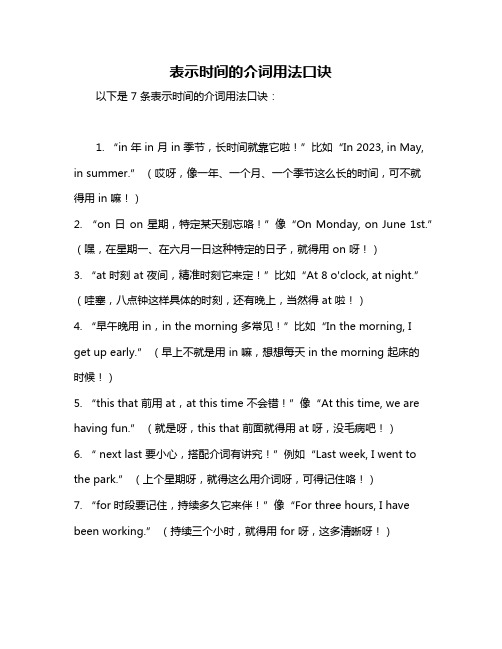
表示时间的介词用法口诀
以下是 7 条表示时间的介词用法口诀:
1. “in 年 in 月 in 季节,长时间就靠它啦!”比如“In 2023, in May, in summer.” (哎呀,像一年、一个月、一个季节这么长的时间,可不就
得用 in 嘛!)
2. “on 日 on 星期,特定某天别忘咯!”像“On Monday, on June 1st.”(嘿,在星期一、在六月一日这种特定的日子,就得用 on 呀!)
3. “at 时刻 at 夜间,精准时刻它来定!”比如“At 8 o'clock, at night.” (哇塞,八点钟这样具体的时刻,还有晚上,当然得 at 啦!)
4. “早午晚用 in,in the morning 多常见!”比如“In the morning, I
get up early.” (早上不就是用 in 嘛,想想每天 in the morning 起床的
时候!)
5. “this that 前用 at,at this time 不会错!”像“At this time, we are having fun.” (就是呀,this that 前面就得用 at 呀,没毛病吧!)
6. “ next last 要小心,搭配介词有讲究!”例如“Last week, I went to the park.” (上个星期呀,就得这么用介词呀,可得记住咯!)
7. “for 时段要记住,持续多久它来伴!”像“For three hours, I have been working.” (持续三个小时,就得用 for 呀,这多清晰呀!)
我的观点结论就是:记住这些口诀,时间介词用法就不会乱啦,超实用的呢!。
英语时间介词的用法大全
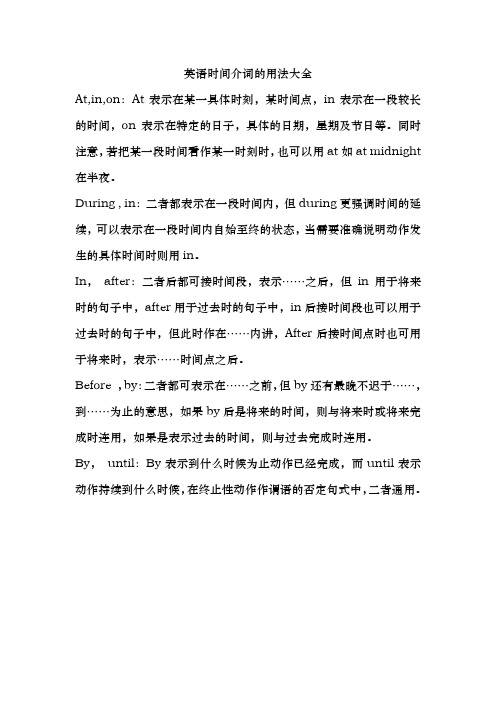
英语时间介词的用法大全
At,in,on:At表示在某一具体时刻,某时间点,in表示在一段较长的时间,on表示在特定的日子,具体的日期,星期及节日等。
同时注意,若把某一段时间看作某一时刻时,也可以用at如at midnight 在半夜。
During , in:二者都表示在一段时间内,但during更强调时间的延续,可以表示在一段时间内自始至终的状态,当需要准确说明动作发生的具体时间时则用in。
In,after:二者后都可接时间段,表示……之后,但in用于将来时的句子中,after用于过去时的句子中,in后接时间段也可以用于过去时的句子中,但此时作在……内讲,After后接时间点时也可用于将来时,表示……时间点之后。
Before ,by:二者都可表示在……之前,但by还有最晚不迟于……,到……为止的意思,如果by后是将来的时间,则与将来时或将来完成时连用,如果是表示过去的时间,则与过去完成时连用。
By,until:By表示到什么时候为止动作已经完成,而until表示动作持续到什么时候,在终止性动作作谓语的否定句式中,二者通用。
关于时间的介词
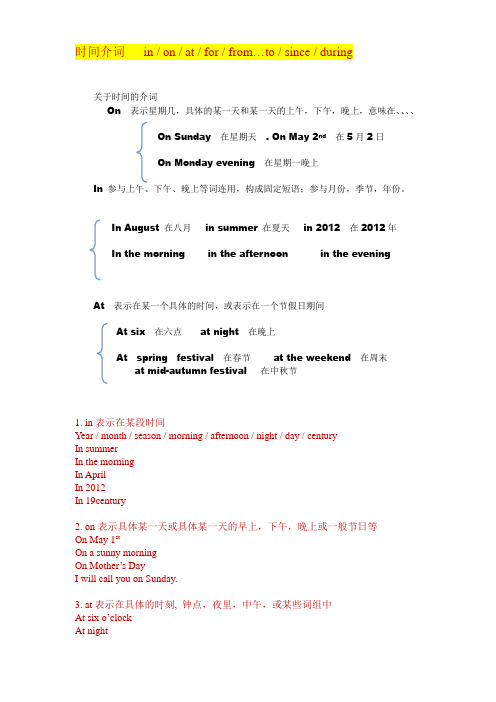
时间介词in / on / at / for / from…to / since / during关于时间的介词On 表示星期几,具体的某一天和某一天的上午,下午,晚上,意味在、、、、On Sunday 在星期天 . On May 2nd在5月2日On Monday evening 在星期一晚上InIn August 在八月in summer 在夏天in 2012 在2012年In the morning in the afternoon in the evening At 表示在某一个具体的时间,或表示在一个节假日期间At six 在六点at night 在晚上At spring festival 在春节at the weekend 在周末at mid-autumn festival 在中秋节1. in表示在某段时间Year / month / season / morning / afternoon / night / day / centuryIn summerIn the morningIn AprilIn 2012In 19century2. on表示具体某一天或具体某一天的早上,下午,晚上或一般节日等On May 1stOn a sunny morningOn Mother’s DayI will call you on Sunday.3. at表示在具体的时刻, 钟点,夜里,中午,或某些词组中At six o’clockAt nightAt the end of …..At lastThe meet will be ended at 10 AM.4. for and inFor + 一段时间,强调某动作或状态持续了多长时间In + 一段时间:表示将来,译为“…..以后”I have been here for a week.She went to Beijing for two days.My father will come back in a week.His uncle is coming to visit him in this summer.5. from…to意思为“从…到…”I often read novel from six o’clock to seven o’clock in the morning.6. since “自从….”I have been teaching English since 2006.It has been raining since last night.7. during 表示在某个特定的时间段之间I will call you during my break time.时间介词in / on / at / for / from…to / since / during 强化练习:( ) 1. Children get gifts ____ Christmas and ____ their birthdays.A. on; onB. at; onC. in; inD. in; on( ) 2.----There is nothing ____tomorrow afternoon, is there?-----No. We can have a game of table tennis.A. onB. inC. outD. up( ) 3. A lot of students in our school were born____March, 1981.A. inB. atC. onD. since( ) 4. He suddenly returned____ a rainy night.A. onB. atC. inD. during( ) 5. My grandfather was born____Oct. 10, 1935.A. onB. inC. atD. of( ) 6. The train is starting___five minutes.A. inB. atC. forD.still( ) 7. Mike does his exercises ____ seven _____ the evening.A. on; toB. at; inC. by; ofD. at; on( ) 8. Children wake up very early____the morning of Christmas Day.A. inB. onC. forD. at( ) 9 ____ a cold winter morning, I met her in the stfeet.A. InB. OnC. AtD. For( ) 10 It happened to be very cold____ the morning of our sports meeting.A. atB. onC. withD. of( ) 11. Why did you get up so early ___ this morning.A. onB. /C. atD. in( ) 12. He went to Shanghai___ September 3rd, 1991 and came back___ a cold morning last ye ar.A. in; onB. on; inC. on; onD. in; in( ) 13. Lucy was born____ the night of May 12, 1984. . ...A. onB. inC. atD. to( ) 14. Mrs. Brown came to China ____ 1996.A.onB. ofC. to,D. in( ) 15 ___ the morning of November 20, 1915, the workers came to Chicago to show their mo urning of Joe Hill.A. OnB. InC. OnD. At( ) 16. Ann moved___Hangzhou___September, 1992.A. /; inB. to; inC. to; on D, in; in( ) 17. They started off___an autumn afternoon.A. duringB. atC. inD. on( ) 18. He often goes ____ school ____ six thirty ____ the morning.A. for; to; inB. to; at; inC. to; for; at D, for; at; to( ) 19. He arrived ___ Shanghai ___ 9: 30 ___ March 5.A. at; in; atB. to; on; atC. in; on; atD. in; at; on( ) 20.The English teacher told me to get there____ half past ten.A: in B. at C. on D. of。
表时间的介词用法

表时间的介词用法
表达时间的介词用法可以根据具体的时间概念和语境来选择合适的介词。
以下是一些常见的时间介词和其用法:
1.On:表示在某一具体的日期、星期几或特定的日期上使用,如"on Monday"(在星期一)、"on April 1st"(在4月1日)等。
2.In:表示在某一段时间、月份、季节或年份内使用,如"in the morning"(在早上)、"in July"(在七月)、"in summer"(在夏天)等。
3.At:表示在具体的时刻、时间点或某个特定的时间上使用,如"at 9 o'clock"(在九点钟)、"at noon"(在中午)等。
4.For:表示持续的一段时间,常与表示时间段的词语连用,如"for three hours"(三个小时)、"for a month"(一个月)等。
5.During:表示在某个时间段或事件发生期间使用,常与表示时间段的名词连用,如"during the meeting"(在会议期间)、"during the summer vacation"(在暑假期间)等。
6.By:表示截止到某个时间或在某个时间之前完成某个动作使用,如"by the end of the week"(在本周结束之前)、"by 5 o'clock"(在五点钟之前)等。
初中英语知识点归纳介词的表示时间与地点
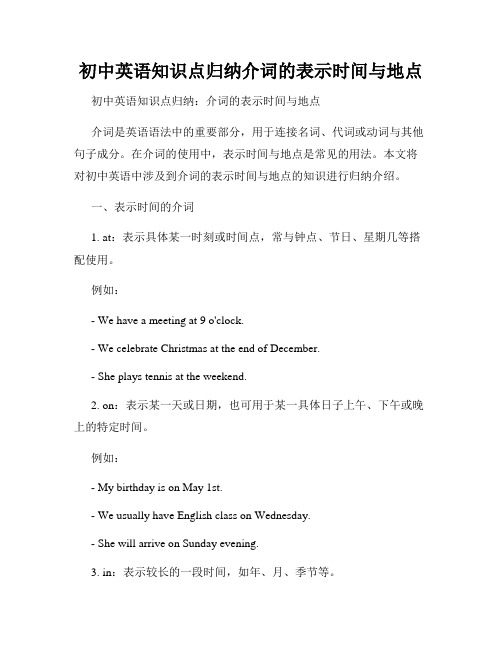
初中英语知识点归纳介词的表示时间与地点初中英语知识点归纳:介词的表示时间与地点介词是英语语法中的重要部分,用于连接名词、代词或动词与其他句子成分。
在介词的使用中,表示时间与地点是常见的用法。
本文将对初中英语中涉及到介词的表示时间与地点的知识进行归纳介绍。
一、表示时间的介词1. at:表示具体某一时刻或时间点,常与钟点、节日、星期几等搭配使用。
例如:- We have a meeting at 9 o'clock.- We celebrate Christmas at the end of December.- She plays tennis at the weekend.2. on:表示某一天或日期,也可用于某一具体日子上午、下午或晚上的特定时间。
例如:- My birthday is on May 1st.- We usually have English class on Wednesday.- She will arrive on Sunday evening.3. in:表示较长的一段时间,如年、月、季节等。
例如:- I was born in 2005.- He will go to Canada in the summer.- They always go skiing in January.4. during:表示在某一段时间内。
例如:- I read a book during the summer vacation.- They have a party during the New Year's holiday.5. for:表示持续的一段时间。
例如:- I have been learning English for five years.- They will stay in the hotel for a week.二、表示地点的介词1. in:表示在一个较大的范围或区域内。
介词的含义及用法
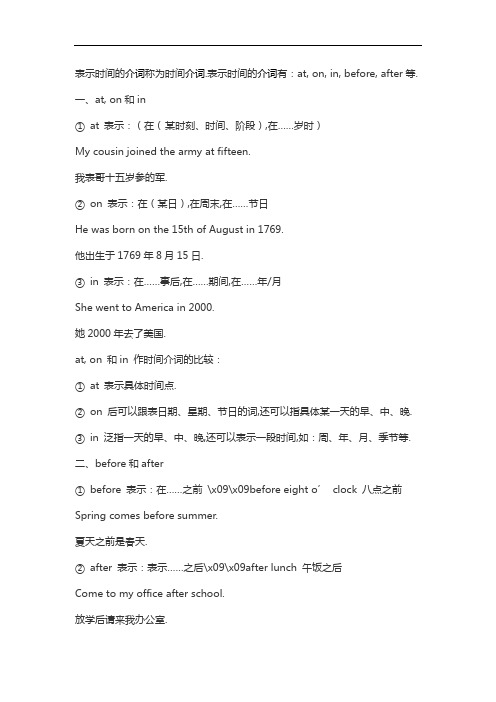
表示时间的介词称为时间介词.表示时间的介词有:at, on, in, before, after等.一、at, on和in①at 表示:(在(某时刻、时间、阶段),在……岁时)My cousin joined the army at fifteen.我表哥十五岁参的军.②on 表示:在(某日),在周末,在……节日He was born on the 15th of August in 1769.他出生于1769年8月15日.③in 表示:在……事后,在……期间,在……年/月She went to America in 2000.她2000年去了美国.at, on 和in 作时间介词的比较:①at 表示具体时间点.②on 后可以跟表日期、星期、节日的词,还可以指具体某一天的早、中、晚.③in 泛指一天的早、中、晚,还可以表示一段时间,如:周、年、月、季节等.二、before和after①before 表示:在……之前\x09\x09before eight o’clock 八点之前Spring comes before summer.夏天之前是春天.②after 表示:表示……之后\x09\x09after lunch 午饭之后Come to my office after school.放学后请来我办公室.表示做某事的方法、手段的介词有by, with, in, at, on.一、byby表示:用,以,靠,通过……方式.by表示手段时后接动作或制作方式.“by + 交通工具”表示交通方式.by bike 骑车\x09by bus 坐公车\x09by taxi 搭出租by train 坐火车\x09by ship 乘船\x09by air 坐飞机Linda usually goes to work by subway.琳达通常做地铁上班.She makes a living by teaching.她考教书谋生.二、withwith 表示:用,以.with表示手段时,后接工具、材料或具体内容.write with a pen 用钢笔写eat with knife and fork 用刀叉吃see with one’s eyes 用眼睛看I killed the fly with a swatter.我用苍蝇拍打死那只苍蝇.She cut the cake with a knife.她用刀切开了蛋糕.三、inin 表示:用,以.in表示用某种方式,如:颜色、笔墨、语言、声音、服饰等.speak in English 用英语说talk in a high voice 高声说话I wrote a letter in ink.我用钢笔写了一封信.Try to express yourself in English.试着用英语表达一下.表示空间的介词有:at, in, on, over, above, under, below 等表示静态位置的介词和from, to, up, down, through, across 等表示动态方向的介词.一、at, on 和in①at 表示:(地点、位置)在……②on 表示:(位置)在……上面③in 表示:(地点、位置或空间)在……里,在……中,在……上Her fans have arrived at the airport.她的影迷已经到达了机场.Look at the picture at the top of the page.请看以下这一项上面的图片.Is my pen on the desk or in the desk?我的钢笔是在桌子上还是在抽屉里呢?Some kids are playing in the yard and others are playing in the room. 有些孩子在院子里玩,其他则在房间里玩.at,on 和in 作空间介词的比较①at用于表示一个较小的场合,这个地点被当作一个点来看待.②on 表示在某一平面或线上,强调与某物体有接触.③in 表示在较大的地方,在某立体空间或平面范围之内.二、about 和around①over 二者都表示:在……周围/各处,围绕.但②above about强调无方向.We walked about in the town.我们在城里到处游逛.Dudu is running around the fence.嘟嘟在绕着篱笆跑.Let’s plant trees around the house.让我们在房子周围栽上树.三、over 和above①under 表示:在……正上方,越过②above 表示:在……上方I saw a wood bridge over the river.我看见河上有座木桥.Look! Some birds are flying above the clouds.看!一些鸟儿在云朵上飞翔.over和above作空间介词的比较①over强调在某人或某物的正上方,而且两物体表面没有接触.②above 强调位置上某物体的上方,并不一定是正上方,而且两物体表面也没有接触.四、under 和below①under 表示:在……的正下方②below 表示:在……下方Please read the words below the picture.请读图片下面的文字.Look! A big mouse hides under the armchair.看!一只大老鼠躲在扶手椅下面.under 和below 作空间介词的比较①under 强调在某物的下方,完全覆盖两物体表面可以接触也可以不接触.②below 强调位置低于某参照物,但并不一定是正下方.五、between 和among①between 表示:(位置、时间、数量等)在……之间(两者之间)②among 表示:在……中间(三者或三者以上之间)I often fly between Beijing and Shanghai.我经常在北京和上海之间飞来飞去.Come here between eight and nine o’clock.请把点到九点之间过来.Susan is among the crowd.苏珊是人群当中.六、into 和out of①into 表示:进来②out of 表示:出去Get out of the room.从房间里出去!Bob walked into the room.鲍勃走进房间.He is working in the office.她在办公室里工作.七、behind 和in front of①behind 表示:在……后面②in front of 表示:在……前面There is a fountain in the front of the park.公园的前面有一个喷泉.Susan sits in front of me and Dudu sits behind me. 苏珊坐在我前面,嘟嘟坐在我后面.八、up 和down①up 表示:往上,向……顶上②down 表示:往下,沿着……往下The monkey is climbing up the tree.猴子正在往树上爬.Tears ran down her face.眼泪从她的脸上流了下来.九、across 和through①across 表示:穿过,跨过②through表示:穿过,通过There is a bridge across the river there.那儿有座桥横跨在河上.A train is running through the tunnel.一列火车正从隧道中穿过.十、by 和near①by 表示:在……旁边②near 表示:在……附近Come over here and stand by me.过来站在我旁边吧.We are planning to camp by the lake.我们打算到湖边露营.There are some big apple trees near the house. 房子附近有一些大苹果树.The new hospital is near our school.新医院里我们学校不远.十一、其他空间介词①along 表示:沿着,顺着②to 表示:到……,去……,向……Let’s walk along the street.让我们沿着街散散步.We drove along the freeway.我们驱车沿着高数公路行驶.The child pointed to the polar star.那孩子指着北极星.I’m going to the bakery.我想要去那家糕饼店.*第一个to表示“指”的方向、目标.第二个to表示到达的目的地.除了按上面介绍表示时间关系、空间关系、方式、手段等的介词外,还有一些重要的介词:一、of 的用法①of 表示:……的(表示所属、所有关系)a cover of this book这本书的封皮a friend of my parents我父母的一个朋友②of 表示:……之中的(表示部分)some boys of the team小组里的几个男生the end of the story故事的结尾Two students of our class joined in the match.我们班里的两个同学参加了这场比赛.All of us approved his plan.我们全都赞成他的计划.③of 表示:……份/量的,……的种类的(表示量、种类)a drop of water一滴水a pair of shoes一双鞋I want two cups of coffee.我要两杯咖啡.二、with 的用法①with 表示:具有,有……的,随身带着It is a dog with black spots.它是一只长着黑色斑点的狗.Take an umbrella with you.带把雨伞吧!②with表示:和……一起,同……一起,偕同I went to Disneyland with my mother.我和妈妈一起去了迪斯尼乐园.Jane likes to play with Mimi.简喜欢和咪咪玩耍.③with 表示:随着……The wine improves with age.这种酒越陈越香.I get up with the sun every day.我每天日出就起床.三、for 的用法①for 表示:为了……(表示目的、用途、利益)Give me a knife for cutting bread.给我一把切面包的刀子.I’ve found it for you.我已经为你找到了它.What can I do for you?我能为你做些什么吗?②for 表示:一段距离或时间He has run for a mile.他跑了一英里.I’ve studied in Beijing for three years.我在北京学习三年了.Please bake the cake for 40 minutes.请将蛋糕烤四十分钟.③for 表示:因为,由于(表示原因)Thank you for your help.谢谢你的帮助.Andy jumped for joy at the good news.安迪听到这个消息高兴的跳了起来.We could hardly see for the mist.由于大雾,我们几乎看不见了.四、like 的用法①like表示:像……(一样),似……(一样)They are like brothers and sisters.他们情同手足.②like 表示:是什么样子,怎样Andy looks just like his father.安迪和他爸爸像极了.五、from 的用法①from 表示:(时间或场所)从……,自……We work from Monday to Friday.我们周一到周五上班.Charlie will fly from New York to London.查理要从纽约飞往伦敦.The cat jumped down from the top of the wall. 猫从墙头跳了下来.②from 表示(两地的距离)离The nearest hospital is 10 miles from my house.最近的医院离我家十英里远.We live about 5 kilometers from Boston.我们住在离波士顿约五公里的地方.③from 表示:出自……,来自……Did you have a (phone) call from him?你接到他的电话了吗?Where are you from?你来自哪里?Susan got a letter from her aunt.苏珊收到一封她姨妈的来信.六、at, about, to 和in 的其他用法①at 表示:对着……, 朝着……,向……(表示方向,目标)He threw a bone at the dog.他用一块骨头砸狗.Please look at the blackboard.请看黑板.Jack shot at the deer but missed.杰克朝鹿开了一枪,但是没有打中.②about 表示:关于……,涉及……He told me a story about ghosts.他给我讲了一个鬼故事.Don’t worry about me.不要担心我.They are talking about English learning. 他们在谈论英语学习.③to 表示:对于,给,向(表示对象)Jane is always very kind to others.简总是对别人很友善.Please send some food to them.请给他们送些食品去.Have you told all the news to John?你把全部的消息都告诉约翰了吗?④in 表示:穿着,戴着Who is the man in black?那穿黑色衣服的人是谁?Tom is in a purple hat.汤姆戴着紫色帽子.The girl in uniform is Mary.穿校服的那个女孩是玛丽.。
常用介词用法及区别整理

1、表示时间的介词(1)at:用于表示时刻,时间的某一点,年龄,就餐时间at noon在午时at night在夜间at present目前(2)on:用于星期几,某天,某一天的上午、下午、晚上(指具体的某一天时,一律用,也可以说是上午、下午、晚上有修饰的一律用ON),特定的时间、含day的节日on Sunday 在星期天on Sunday morning 在星期天的上午on March 8 在3月8日(3)in:用于表示周、月、季节、年、泛指上午、下午、晚上。
in 1999 在1999年in November 在11月份in summer 在夏季in the afternoon在下午in + 时间段:过……后(内),用于将来时I think he will be back in an hour.我想他一小时后就会回来。
I heard that she would be back in a month.我听说她一个月后回来的。
(4)after:在……之后after that ,no one should ever kill a seagull .从那时起,任何人不得捕杀海鸥。
after + 时间段:在……之后,用于过去时。
.(5)before:在……之前Wei hua got up before 7 o’cl ock this morning .今天早晨,魏华在7点之前起床了。
He won’t come back before five.(6)by:到……为止,截止(到)……By the time i arrived ,she had already gone .在我到达之前,她已经走了。
The work must be finished by Friday.We had three meetings by last Friday.(7)for:达……之久(表示过了多少时间),可以和一般现在时,过去时,将来时连用,但是经常和完成时连用。
英语常用介词

嘟嘟在绕着篱笆跑。
Let’s plant trees around the house.
让我们在房子周围栽上树。
三、over 和 above
① over 表示:在……正上方,越过
② in front of 表示:在……前面
There is a fountain in the front of the park.
公园的前面有一个喷泉。
Susan sits in front of me and Dudu sits behind me.
苏珊坐在我前面,嘟嘟坐在我后面。
① across 表示:穿过,跨过
② through表示:穿过,通过
There is a bridge across the river there.
那儿有座桥横跨在河上。
A train is running through the tunnel.
一列火车正从隧道中穿过。
十、by 和 near
at,on 和 in 作空间介词的比较
① at用于表示一个较小的场合,这个地点被当作一个点来看待。
② on 表示在某一平面或线上,强调与某物体有接触。
③ in 表示在较大的地方,在某立体空间或平面范围之内。
二、about 和 around
① 二者都表示:在……周围/各处,围绕。
② above about强调无方向。
苏珊是人群当中。
六、into 和 out of
① into 表示:进来
② out of 表示:出去
Get out of the room.
- 1、下载文档前请自行甄别文档内容的完整性,平台不提供额外的编辑、内容补充、找答案等附加服务。
- 2、"仅部分预览"的文档,不可在线预览部分如存在完整性等问题,可反馈申请退款(可完整预览的文档不适用该条件!)。
- 3、如文档侵犯您的权益,请联系客服反馈,我们会尽快为您处理(人工客服工作时间:9:00-18:30)。
常用表示时间的介词
一、at,on,in
(A)at表示“在某一时刻,某一时点”。
如:
I get up at 6:00 every day.我每天6点起床。
注:at daybreak在黎明;at noon在中午;at night在夜间;at Christmas在圣诞节期间;at the age of five在五岁时。
(B)on表示“在具体某一天或某天的上、下午”。
如:
I heard a shot on (the morning of )March 18.三月十八日(早晨)我听到一声枪响。
We don’t have classes on Sunday.星期天我们不上
(C)in表示“在某世纪、年、季度、月、周”以及泛指的上、下午、晚上。
如:in the 20th century在20世纪;in 1999在1999年;in winter在冬季;in September在九月;in the morning/afternoon/evening 在上午/下午/晚上。
二、for,during,through
(A)for后接“一段时间”,表示某事持续多久,多与完成时连用。
如:
She has been ill for several days.她已经病了几天了
(B)during表示“在……期间”。
如:
I went to France for two weeks during the summer.夏天我去了法国两个星期。
(C)through表示“一直……,自始至终”。
如:
They worked hard through the winter.整个冬天他们都在努力工作。
三、from,since
(A)from表示“时间的起点”,可译作“从……”,多用于“from…to/till…”中。
如:You can come anytime from Monday to Friday.周一至周五你什么时间来都行。
(B)since表示“自从……以来(直到现在)”。
如:
He has been away from home since 1973.他自从1973年就离开了家乡。
We have known each other since ten years ago.我们十年前就认识了。
注意:for和since都常与完成时连用,但for接时间段,since接时间点。
如for two hours (持续)两小时;since last week从上周直到现在。
四、before,by,till,until
(A)before指“在……之前”,与after相对。
如:
Please come before ten o’clock.请10点以前来。
(B)by指“不迟于,到……时为止,在……以前”。
如:
We had learned over 1000 words by the end of last term.到上学期末为止,我们已经学了1000多个单词了。
We will have learned 2000 English words by the end of this term.到本学期结束前,我们将学了两千英语单词了。
注:by后接过去时间,常与过去完成时连用;by后接将来时间,常与将来完成时连用。
(C)till (until)“直到……为止”。
如:
You must wait for him till tomorrow.你必须一直等到他明天。
注:在肯定句中,till/until必须与延续动词连用;在否定句中,till/until常与非延续性动词连用。
如I didn’t go to bed until 12 o’clock.直到12点我才睡。
五、after,in,within
(A)after表示“在……之后”,是before的反义词。
如:
He got a cancer and died after a year.他患了癌症,一年后去世了。
The meeting will end after 3:00pm.会议将在下午三点后结束。
(B)within“在……时间之内”。
如:
I can finish it within an hour.我不需一小时就可把它做完。
注:after与in都可表示“在……之后”,但after后可跟时间段,也可跟时间点;而in 后必须跟时间段。
after既可用于将来时,也可用于过去时,而in只能用于将来时。
I’ll arrive in an hour.我一小时后到达。
